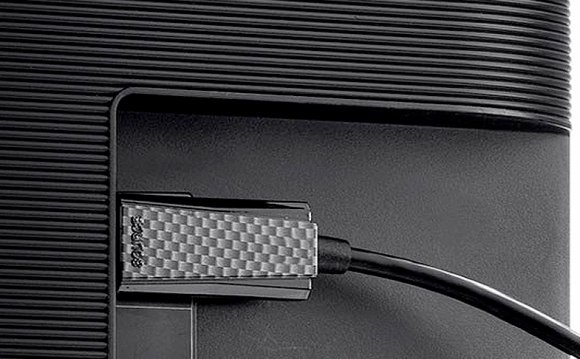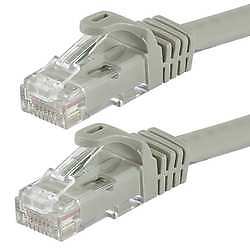
 Ethernet cables are used to connect computers to networks, modems, or routers via a wired connection. The cables transmit data through twisted pairs of copper wire or solid core wires in RJ-45 connectors. Twisted pair cables are made up of four twisted pairs of copper wire. In some cases only two pairs are used to transmit information, but in faster cables all four pairs are used. Wired connections are often more stable and reliable than wireless connections. Different types of cables are used for different applications and different distances. In most Ethernet cables, the signal degrades over distance. The type of cable used affects the network speed and connectivity, and it is therefore important to use the right cable for the right application. Choosing the right type of Ethernet cable depends on the network type and speed, the distance and terrain to be covered, and the cable's function. Shoppers can find Ethernet cables at PC shops and online.
Ethernet cables are used to connect computers to networks, modems, or routers via a wired connection. The cables transmit data through twisted pairs of copper wire or solid core wires in RJ-45 connectors. Twisted pair cables are made up of four twisted pairs of copper wire. In some cases only two pairs are used to transmit information, but in faster cables all four pairs are used. Wired connections are often more stable and reliable than wireless connections. Different types of cables are used for different applications and different distances. In most Ethernet cables, the signal degrades over distance. The type of cable used affects the network speed and connectivity, and it is therefore important to use the right cable for the right application. Choosing the right type of Ethernet cable depends on the network type and speed, the distance and terrain to be covered, and the cable's function. Shoppers can find Ethernet cables at PC shops and online.
Types of Ethernet Cables
A number of different types of Ethernet cables are available on the market today. The different types are most commonly identified according to category definitions, but they can also be differentiated by the types of plugs used.
Ethernet Cable Categories
Ethernet cabling categories are defined by the Electronic Industries Association and the Telecommunications Industry Association (EIA/TIA). Categories are defined according to each type of cable's performance, and the network speed and frequency (or bandwidth) it can support. The table below gives a brief description of the most common types of cabling available.
Ethernet Cable Type |
Description |
|---|---|
|
Cat 3 |
Older networks worked with Cat 3 cable and this type of cable is no longer readily available. It supports 16 MHz bandwidth, 10 Mbps Ethernet connections, and can be used for voice and telephony. |
|
Cat 5 cable is backwards compatible with Cat 3 applications, but supports 100 MHz bandwidth and 10/100 Mbps Ethernet connections. |
|
|
Cat 5E is the enhanced version of Cat 5 and is most common. However, with constant increases in internet speeds, Cat 5E is becoming a budget option. Cat 5E helps to prevent electromagnetic interference and can support Ethernet connections of 10/100/1000 Mbps, and 100 to 400 MHz bandwidth. 1000 Mbps Ethernet is also known as Gigabit Ethernet. All four wire pairs in the cable are used. |
|
|
Cat 6 cables are backwards compatible with all other cables. They are like Cat 5E cables, but have larger gauge wires and work for Ethernet connections up to 10 Gbps. They support up to 250 MHz bandwidth. Cat 6 cables were developed with Gigabit Ethernet in mind. Those who are upgrading their network cables should consider installing Cat 6 as this will eliminate the need to upgrade again in the near future. When installing cables for 10Gbps Ethernet, Cat 6 cables can be used over distances of up to 185 feet, but Cat 6a should be used for distances up to 300 feet. |
|
|
Cat 7 cabling is also known as Class F. This fully shielded variety supports bandwidths of up to 600 MHz, but is not used for home networking. |
As mentioned above, Cat 5E cables are the most common and economical cables available, but Cat 6 should be considered when upgrading a home network.
Ethernet Cable Plugs
Ethernet cables come with a plug at each end. The type of plug or connection determines the cable's use. The typical, most common cable is known as a straight-through cable. If one holds the ends side by side one can see that the smaller colored wires that make up the cable are in the same color order from left to right. These cables are used to connect two different devices, for example a PC to a hub or switch, or a router to a switch.
A crossover cable has different plugs on either end. This type of cable is used to connect two similar devices to one another without a switch in the middle. The middle component usually performs the crossover function. In other words, a crossover cable can be used to connect a PC directly to another PC, or one switch to another.
Ethernet Cable Construction
Ethernet cables are constructed in a number of ways. Simpler constructions are usually needed for home networking, but it is important to understand the terms used in item descriptions.
Unshielded Twisted Pair (UTP) and Shielded Twisted Pair (STP) Cables
As mentioned previously, Ethernet cables are usually made up of four twisted pairs of copper wire. Cables can be further categorized as unshielded twisted pair ( UTP ) or shielded twisted pair ( STP ). Shielded twisted pair cables are designed to prevent interference from other devices and generally yield higher performance. However, they are seldom used in, or necessary for, home networking. They are also more expensive than UTP cables.
Stranded and Solid Core Cables
Ethernet cables used in home networking are usually stranded rather than solid. This means that each cable is made up of thin individual strands of copper wire that add up to 22 to 24 gauge thickness when twisted together. This type of cabling is best for extreme bends and patch cables. Solid core cables have one solid 22 to 24 gauge copper wire. They transmit signals more easily and are best for long runs, but are not flexible. Too much bending can lead to broken wires. They are commonly used inside walls and where a network is installed during the construction phase of a building.
Ethernet Cable Coatings
Ethernet cables are usually coated with PVC. However, as PVC releases toxic fumes when burning, PVC encased cables are seldom used in air handling spaces. In fact, some local fire codes prohibit its use in these areas. Plenum rated cables are used instead. Plenum is not a type of coating; these cables are usually coated with flame retardant smoke reducing PVC or Teflon. The name comes from the construction term for a building's air handling space (plenum). Plenum rated Ethernet cables are seldom used in home networking and are generally significantly more expensive than PVC coated cables.
Armored, outdoor, aerial duct, and direct burial cables offer additional protection against the elements and can be used in more rugged environments. They protect against water or foreign matter entering the cable housing or coming into contact with the cable's wiring. Additionally, these durable cables feature corrosion resistance, and prevent damage from abrasion. They come with a variety of tougher coatings. However, these cables are seldom needed for home networking.
Choosing the Right Ethernet Cable
To choose the right category of Ethernet cable, one must determine one's connection speed. Cat 5 or 5E is adequate for connections up to 100 Mbps, but Cat 6 cable should be considered for faster connections. The next step is to determine the length of cable needed. Signal tends to degrade in longer cables, and shorter cables are faster with a clearer signal. For distances of 100 m or more one should consider Cat 6 or 6a. Cat 5E is best for 100 m or less, and Cat 5 for distances below 20 m. Lastly, one should select the appropriate plug type. Altogether, the most common cables used for home networking are Cat 5E or 6, straight-through, stranded, unshielded twisted pair, PVC coated cables.
Finding Ethernet Cables on eBay
Ethernet cables are listed in eBay's Computers, Tablets and Networking section, in the Cables and Connectors category, under Networking Cables and Adapters. You can use the menus on the page to refine your search. Alternatively, typing a keyword into the search box or using the advanced search option allows you to expand or narrow search results. Visit eBay Stores to see additional listings.
YOU MIGHT ALSO LIKE












